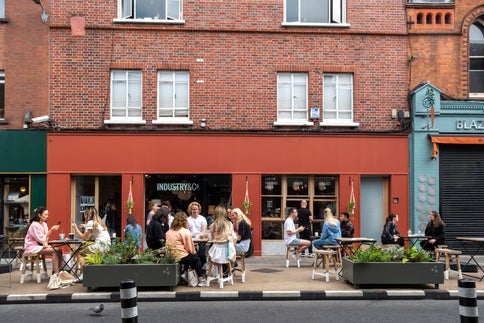- Home
- Traveller guides
- 10 free museums in Dublin
10 free museums in Dublin


Dublin has an impressive artistic heritage, with a wide range of museums and galleries spread throughout the city.
As you’d expect from a capital, most of the country’s cultural heavy hitters are here, but unlike other cities the majority are free to visit. You’ll find three branches of the National Museum of Ireland, the country’s most important cultural institution, as well as Ireland’s most prominent galleries, which don’t cost a cent to explore. You can even visit the president’s official residence for free.
Here's how to enjoy Dublin’s rich artistic and cultural patrimony without paying a penny.
- 1.
- 2.
- 3.
- 4.
- 5.
- 6.
- 7.
- 8.
- 9.
- 10.
National Print Museum
You don’t need to be a printing enthusiast to get a kick out of the National Print Museum, housed in what was once the Garrison Chapel of the 19th century Beggars Bush Barracks in Dublin 4. The history of printing in Ireland is told in fascinating detail through displays and presses, including a replica of the Gutenberg press used in the TV series The Tudors. The museum also has one of 200 original 1916 Proclamations, alongside a Wharfedale press used to print the revolutionary declaration in secret ahead of the Easter Rising.
The museum is free to visit, but you can also join a guided tour (€6), which tells the story of printing and the museum in colourful, fun detail. You even get to print something at the end of it. On Thursdays the founders of the museum – a group of retired printers known as ‘the Chapel’ are on hand with stories, anecdotes and demonstrations of the still-working machines. The museum also hosts a changing rota of exhibits and workshops.
National Museum of Ireland, Kildare Street
The original home of the National Museum of Ireland is this handsome Victorian Palladian style building on Kildare Street, which opened in 1890. Today, it’s where you’ll find the museum’s archaeological collection, including some of Ireland’s best-known treasures like the Ardagh Chalice and the Tara Brooch. They’re part of Ór – Ireland’s Gold, which features arguably the finest Celtic metalwork in the world; other standouts in the collection are the Broighter Hoard and the Loughnashade bronze war trumpet, dating from the 1st century BC.
The museum’s other big draw is the Kingship and Sacrifice exhibit, which features four ‘bog bodies’ – Celtic figures in various states of decomposition that were dug out of Irish bogs. Some of the detail is remarkable, as are the stories of how they likely met their end. Upstairs is a section devoted to medieval Ireland as well as a collection of artefacts from Ancient Egypt.
National Museum of Ireland, Collins Barracks
Once the world’s largest military barracks, this impressive neoclassical building on the north side of the Liffey is home to the National Museum of Ireland, Collins Barracks. The diverse collection includes exhibits on Irish soldiering from 1550 to the present day, the story of the Easter Rising, a whole section dedicated to changing fashions over the last 250 years and a permanent exhibit on designer Eileen Gray. You’ll also find the restored Asgard, a yacht that ran guns for Irish revolutionaries in 1914. These exhibits and more are housed within a building that itself is worth a visit: the central courtyard at Collins Barracks, surrounded by elegant, arcaded colonnades, is so big that 6,000 soldiers could parade here without bumping into each other.

National Museum of Ireland, Merrion Street
The third branch of the National Museum of Ireland in Dublin is the National Museum of Ireland, Merrion Street, which opened in 1857 with a ribbon-cutting by Scottish explorer Dr David Livingstone, who later disappeared in Africa only to be found by Henry Stanley in 1871 with the famous line, “Dr Livingstone, I presume?” The collection at the ‘Dead Zoo’ numbers around 10,000 exhibits, with highlights including the skeletons of three 10,000-year-old Irish elk and a 20m-long blue fin whale found on a County Sligo beach.
While the Merrion Street museum is currently closed for restoration and conservation work, visitors are invited to explore The Dead Zoo Lab at the National Museum of Ireland, Collins Barracks, and enjoy some of the most popular specimens from the natural history collection, as well as some specimens that haven’t been on display for many years.

National Gallery of Ireland
Ireland’s most important art collection lines the walls of the National Gallery of Ireland on Merrion Square. The four wings cover 500 years of European and Irish art, with some of the biggest stars represented: Vermeer, El Greco, Goya, Caravaggio, Rembrandt, Monet and Picasso. The collection of Irish art is exceptional, not least the works of Jack B Yeats, which includes some of his most famous paintings like ‘The Liffey Swim.’ One of the gallery’s best-known paintings, Frederic William Burton’s ‘Hellelil and Hildebrand, the Meeting on the Turret Stairs,’ is so sensitive to light that it is only displayed twice a week, on Thursdays from 11.30am-12.30pm and Sundays between 2-3pm.
The gallery also runs a regular schedule of free guided tours, which are tailored to suit interests and even needs: besides a basic highlights tour, there are tours for parents with newborns, sign language tours, a tour dedicated to slow art and mindfulness, and 'turas trí Gaeilge' (tour through Irish). On Thursdays, the gallery opens until 8.30pm and occasionally features free evening events; it's also a good time to visit for fee-charging temporary exhibitions as they offer a reduced rate.


Chester Beatty
One of the world’s most important collections of rare manuscripts and artistic treasures is in the wonderful Chester Beatty, on the grounds of Dublin Castle. Spread across two fascinating floors, the exhibits include the world’s second-oldest biblical fragment (after the Dead Sea Scrolls), the best collection of Chinese jade books on the planet and perhaps the most beautiful selection of illuminated Qurans outside of the Middle East. In between you’ll find beautiful Japanese woodblock prints, Chinese paintings, medieval manuscripts and Buddhist texts. That they’re in Ireland at all is all thanks to mining magnate and lifelong art collector Sir Alfred Chester Beatty (1875-1968), who established the museum in 1954 and bequeathed the whole collection to the Irish State upon his death.
The museum also has a regular programme of diverse events, many of which are free, including Qi Gong in the beautiful roof garden, film screenings and talks. Many take place on a Wednesday, when the museum is open until 8pm. Free public tours of the collection take place every Wednesday at 5.30pm, Saturday at 11am and Sunday at 3pm.

Irish Museum of Modern Art (IMMA)
Ireland’s most important collection of modern and contemporary art is stored within the walls of the Irish Museum of Modern Art (IMMA) at the Royal Hospital Kilmainham, west of the city centre. The mainstay of the collection features Irish and international art from 1940 onwards, including works by Joan Miró and Pablo Picasso as well as Irish artists such as Dorothy Cross and Robert Ballagh. There are new works added every year and there’s a constantly changing programme of temporary exhibits. There are free 30-minute tours of the museum at 2.30pm on Wednesday, Saturday and Sunday; no booking is required and all tours start from the main reception.
The impressive building is modelled on Les Invalides in Paris and opened in 1687 as a retirement home for soldiers; the 48-acre grounds include beautiful landscaped gardens and are great for walks; from June to September host IMMA Outdoors, a programme of free events including talks, screenings, workshops and the ever-popular Music in the Courtyard series.

National Library of Ireland
With more than 12 million books, photographs and documents, the National Library of Ireland is the country’s library of record. The big attraction is the main reading room, a large space that features in James Joyce’s Ulysses (where Stephen Dedalus gives his poorly attended lecture on Shakespeare and Hamlet). Otherwise, there’s a permanent exhibition on the life and works of WB Yeats as well a regular series of guided tours, including a monthly one led by the director of the library.
The library is free to visit, but you’ll have to apply online for a reader’s ticket, usually a day in advance. The ticket then gives you access to all of the reading rooms and the Family History Room, the library’s genealogical research service. Consultations are free, but you need to make an appointment in advance.
The James Joyce Tower and Museum
More than just a small museum dedicated to the works of Dublin’s most famous author, the James Joyce Museum in Sandycove is a living piece of Joycean history. It’s housed in one of the famous Martello Towers built in the early 19th century to ward off a possible Napoleonic invasion, and it is where Joyce spent six nights in 1904. It must have made a bit of an impression, because he opted to use the tower for the opening scenes of Ulysses: it’s where ‘stately, plump Buck Mulligan’ lived with Stephen Dedalus. The collection is small but impressive: it features old photographs and mementos of the author, as well as early copies of his books and even two death masks.

Áras an Uachtaráin
The official residence of the president of Ireland, Áras an Uachtaráin is free to visit by guided tours on most Saturdays. You can pick up a first-come, first-serve ticket (be sure to bring photo ID) from the Phoenix Park Visitor Centre for one of the tours, which go at 10am, 11.15am, 12,30pm, 1.45pm and 3pm.
During the 75-minute tour you’ll learn the history of the house, which was built as the viceregal lodge in 1751 based on a design by amateur architect Nathaniel Clements. The tour takes you through the official function rooms and into the gardens; you’ll also hear how the distinctive, four-pillared portico on the garden side served as an inspiration for the portico on the White House in Washington, DC.
Enjoy more and spend less
You don’t need to rely on free museums to have a bargain time in Dublin. Discover how to enjoy the capital on a budget.



